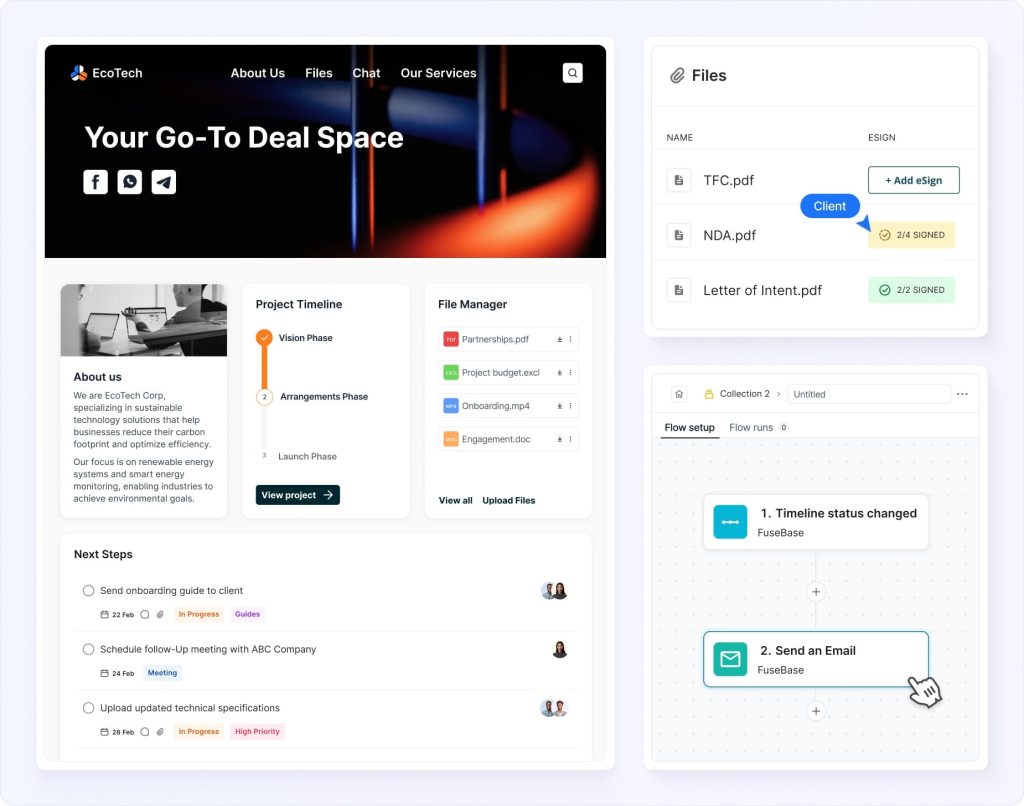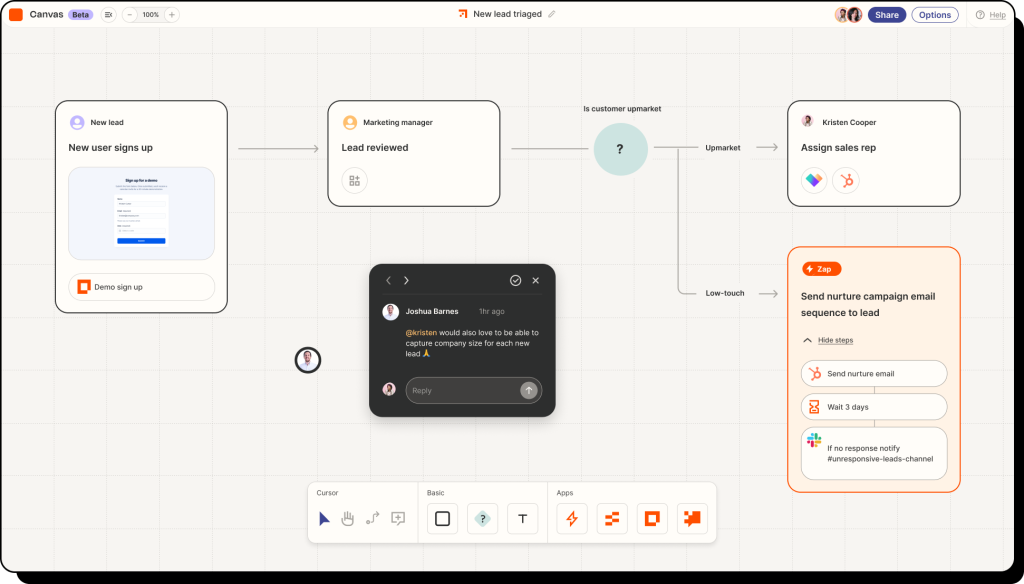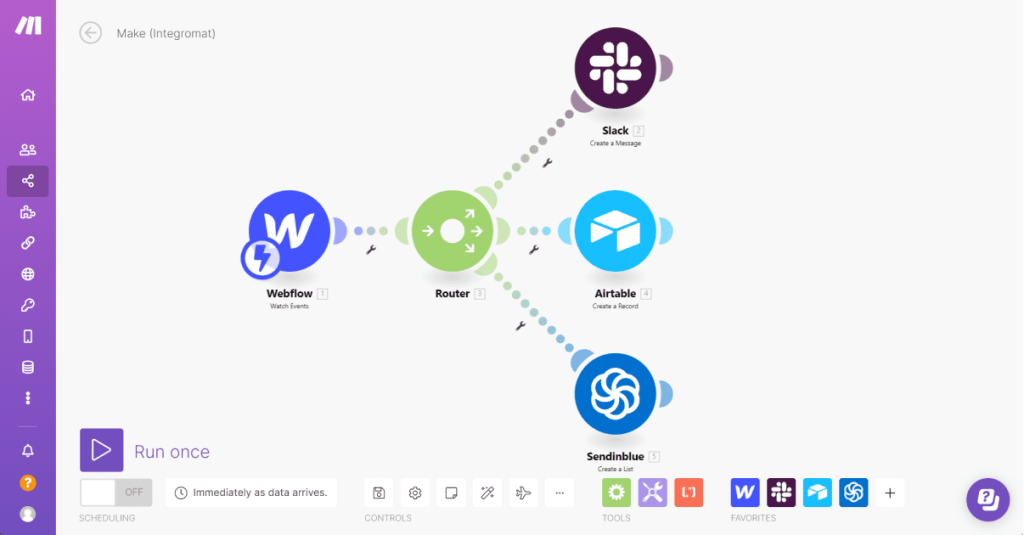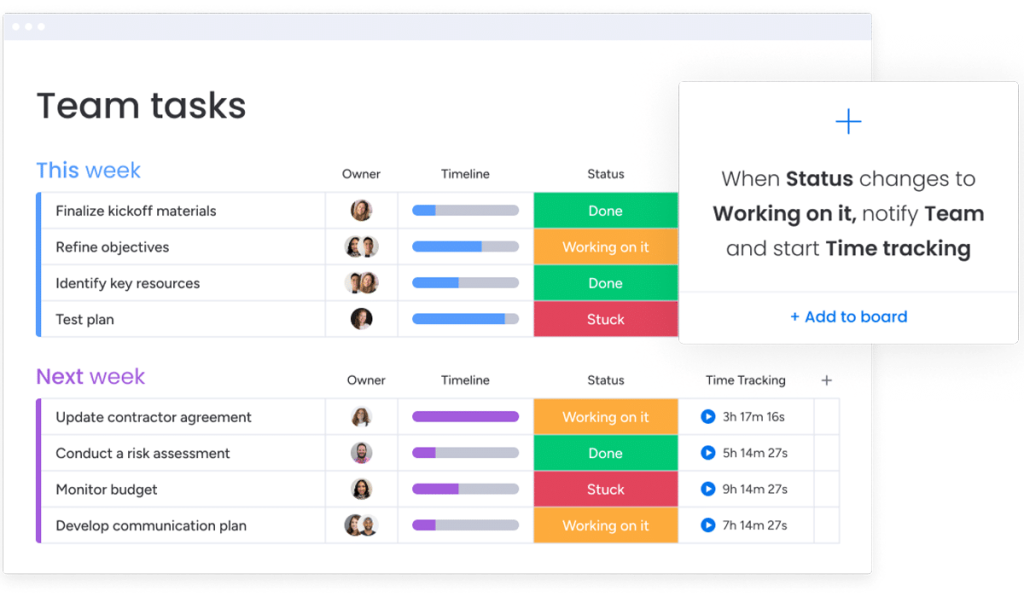
The way businesses manage tasks and processes is changing rapidly. In 2025, workflow automation software is more powerful and accessible than ever, offering a competitive edge to teams that embrace it. Whether you’re a small business looking to eliminate manual data entry or an enterprise aiming to optimize cross-functional collaboration, the right automation tool can save time, reduce human error, and boost team productivity.
But with hundreds of tools on the market, how do you choose the one that fits your needs? In this guide, we’ve curated the top workflow automation software options for 2025. From no-code platforms to advanced automation suites, you’ll find the right solution to streamline your workflows and scale your business operations effectively.
TL;DR – Best Workflow Automation Software by Use Case
- FuseBase – Best for service teams needing client-facing workflows, document automation, and branded portals
- Zapier – Best for non-technical teams connecting SaaS tools with simple cross-app automations
- Make (Integromat) – Best for technical teams building advanced, multi-branch automations with APIs
- Kissflow – Best for enterprise departments (HR, finance, IT, procurement) with compliance-driven processes
- Monday.com – Best for creative and cross-functional teams managing visual projects with light automation
What is Workflow Automation Software?
Workflow automation software is a digital tool that helps businesses streamline and manage recurring tasks and processes by automatically triggering actions based on predefined rules. It replaces manual workflows – such as approvals, notifications, data entry, and file transfers—with automated sequences, saving time and reducing human error. The best workflow automation software goes beyond simple task handling, offering advanced integrations, AI-assisted triggers, and customizable no-code builders to fit every team’s needs.
Key Features of Best Workflow Automation Software
In 2025, the best workflow automation software empowers teams to build intelligent, scalable systems that adapt to their unique needs. Here are the standout features that define modern, high-performance platforms:
- AI-Assisted Automation – Smart suggestions, predictive triggers, and AI-generated workflows help users build faster and more efficiently.
- No-Code Customization – Flexible visual editors allow users to create complex workflows without writing a single line of code.
- Multi-App Integrations – Seamless connections with tools like Slack, Google Workspace, Microsoft Teams, HubSpot, and more ensure smooth cross-platform operations.
- Real-Time Sync and Triggers – Instant updates across tools and devices reduce lag, errors, and duplicate work.
- Security and Compliance – Due to increasing data regulations, prioritize encryption, audit logs, and adherence to standards such as GDPR and SOC 2.
- Smart Reporting Dashboards – Built-in analytics visualize workflow efficiency, task completion rates, and user performance at a glance.
These features reflect the future of workflow automation – intelligent, flexible, secure, and built for real-time collaboration in a hybrid work world.
Who Needs to Use Workflow Automation Software
As businesses become more digital and fast-paced, workflow automation software is evolving from a “nice-to-have” to a “must-have.” The top tools are designed for versatility, making them essential for a wide range of users across industries:
- Remote and Hybrid Teams: With dispersed teams, automated workflows ensure alignment, accountability, and real-time visibility – no matter where team members are.
- Agencies and Client-Facing Teams: From client onboarding to deliverable approvals, automation reduces turnaround times and improves the overall experience.
- Enterprise Departments: Sales, finance, and IT departments within larger organizations use automation to maintain consistency across complex processes.
- Compliance-Driven Industries: In sectors like healthcare, finance, or legal, automation supports regulatory requirements with proper documentation, audit trails, and approval tracking.
Best 5 Workflow Automation Software
Below are 5 of the most effective workflow automation platforms in 2025 – each highlighted for its unique strengths and the specific types of teams and industries it serves best.
1. FuseBase

FuseBase stands out as an all-in-one platform that brings together workflow automation, branded client collaboration, project tracking, smart forms, and document management – wrapped in a beautifully simple, customizable portal. It enables users to build powerful automations triggered by file uploads, form submissions, or task changes, while also offering AI assistance for summaries, responses, and insights. You can also build workflows that connect folders, auto-tag documents, or notify specific team members with zero code.
Key Features:
- Visual no-code workflow builder with smart triggers (file, form, task)
- AI assistant for document summaries, chat replies, and automation setup
- Fully branded, permission-based client portals
- E-signature integration, embedded forms, and document analytics
- Folder automation presets and reusable templates
Pros:
- Combines project management, automation, and client collaboration in one
- Ideal for multi-step, document-heavy, service-based workflows
- Intuitive UI for both teams and clients
- Fast and responsive support, with regular product updates
- AI features save time and enhance automation logic
Best For:
FuseBase is tailor-made for professional services teams who need both internal operational efficiency and external client transparency. If your workflows involve client onboarding, deliverable approvals, task collaboration, or content review in branded portals, FuseBase is purpose-built for you. Its combination of automation, AI, and collaboration makes it ideal for agencies, consultants, law firms, accountants, and service-based teams.
Pricing:
- Free plan available
- Solo: $32 per month (for personal use)
- Essentials: $82 per month (for small teams – 5 members)
- Advanced: $332 per month (for larger teams – 50 members)
- Unlimited: custom pricing
2. Zapier

Zapier enables you to automate repetitive tasks by linking over 5,000 apps together using “Zaps.” These automated workflows can perform simple tasks (e.g., send an email when a form is filled) or multi-step processes with conditional logic. It’s incredibly beginner-friendly, yet powerful enough for intermediate users to build cross-app workflows that run on autopilot.
Key Features:
- No-code automation builder
- Multi-step workflows with filters, paths, and delays
- Scheduled or real-time triggers
- Integration with virtually every major SaaS product
- Easy-to-use dashboard with workflow logs and performance monitoring
Pros:
- Huge integration library
- Fast to deploy, even with minimal tech knowledge
- Streamlines tasks across dozens of apps
- Excellent help docs and community forums
Best For:
Zapier is the go-to tool for businesses that rely heavily on multiple SaaS applications. If your workflows span different platforms (e.g., Google Sheets, Slack, HubSpot, Trello), Zapier allows you to connect them all without writing a single line of code. It’s ideal for marketers, sales teams, operations professionals, and entrepreneurs managing a growing stack of tools.
Pricing:
- Free plan available
- Professional: from $19.99/month
- Team: from $69/month
- Enterprise: custom pricing
3. Make (formerly Integromat)

Make provides a visual “scenario” builder that allows users to build workflows by connecting modules, APIs, webhooks, and conditions. It’s designed to support highly customized automations involving detailed logic, conditional paths, and advanced data transformation.
Key Features:
- Advanced visual workflow builder with real-time feedback
- HTTP module for API connections
- Routers and filters for complex conditional logic
- Scenario scheduling and error handling tools
- Execution history and detailed monitoring tools
Pros:
- Unmatched control over automation logic
- Great value for technically complex workflows
- Transparent execution paths and real-time debugging
- Support for custom APIs and endpoints
Best For:
If your team has a technical background and requires sophisticated, multi-branch automation scenarios, Make is one of the most flexible options available. It’s perfect for developers, IT teams, system integrators, and data engineers who need control over every node in their workflow.
Pricing:
- Free plan available
- Core: from $9/month
- Pro: from $16/month
- Teams: from $29/month
- Enterprise: custom pricing
4. Kissflow

With a focus on business process automation, Kissflow allows users to build custom workflows for approvals, request handling, procurement cycles, and employee management. Its strength lies in helping enterprises standardize operations, enforce SLAs, and ensure audit compliance.
Key Features:
- Process modeling and rule-based logic
- Form builder with conditional workflows
- Department-based templates (HR, IT, finance, procurement)
- Role-based access, SLA tracking, and audit logging
- Reports and process analytics
Pros:
- Built for compliance-heavy teams
- Excellent scalability and permissions management
- Strong support for structured, repeatable processes
Best For:
Kissflow is built for large organizations that need strict governance over process-driven workflows. It’s best suited for enterprise departments like HR, procurement, IT, and finance, where form-driven automation and structured workflows are essential.
Pricing:
- Basic: from $1,500/month (50 users)
- Enterprise: custom pricing
5. Monday.com

Monday.com combines project management with automation by allowing users to create boards that track work visually. Users can add rules to automate repetitive actions like assigning team members, changing statuses, or sending reminders.
Key Features:
- Color-coded boards with multiple views (Gantt, Calendar, Kanban)
- Custom automation builder for task flows
- File sharing, comments, and mentions for collaboration
- Integration with Slack, Teams, Google Workspace, and more
- Templates for marketing, CRM, HR, and operations
Pros:
- Visually intuitive and great for teamwork
- Fast onboarding and friendly interface
- Ideal for project-oriented teams
Best For:
Monday.com is ideal for creative and cross-functional teams that want to manage projects and tasks visually, while layering in automation to reduce busywork. It’s popular in marketing, product, and operations teams where visual status tracking and collaboration are essential.
Pricing:
- Free plan available
- Basic: from $9/user/month
- Standard: from $12/user/month
- Pro: from $19/user/month
- Enterprise: custom pricing
Summary
As businesses continue to digitize and scale, the demand for powerful, flexible, and user-friendly workflow automation software has never been higher. The tools highlighted in this article each bring unique strengths, whether it’s seamless integrations, complex logic handling, or checklist-style simplicity. But when it comes to offering a comprehensive, modern solution that balances automation, collaboration, and client experience, FuseBase stands out as the best pick for 2025.
Whether you’re automating onboarding, document approvals, or recurring service workflows, this software gives you the tools to move faster, work smarter, and scale with confidence. If you’re looking for a platform that adapts to how you work – and elevates how you serve your clients –FuseBase is the top workflow automation software to consider this year.
